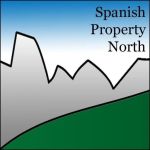As you travel further west, leaving Aviles (and the airport) both the physical and the architectural landscape of Asturias change gradually. The mountains become less typically Asturian (jagged and abrupt) and more Galician (rolling and rounded), the line between the coast and the mountains widens a little and the land is flatter and more open. The roof tiles change from rounded terracotta to flat, grey slate; the horreos from square, chestnut beamed granarys to narrow, stone-built ones.
The recently completed motorway, the A-8, traverses the land here, bisecting the plain below the mountains making travel easy and fast and leaving previously out-of-the-way beaches and fishing villages accessible. So if we define western Asturias as anything west and south of San Juan de las Arenas up until the very natural border with Galicia at the estuary of Ribadeo, then we can see that it’s the least populated part of Asturias and, in the main, outside of the regions served by the motorway it is less easily navigated.
Yet, close to the coast, in the flat strip which the motorway crosses and before the hills rear up, the land is fertile, flat and the climate is warm and welcoming with very mild winters. There are stunning fishing villages and a glut of incredible beaches that outisde of a three month period you can almost have to yourself. This is a part of Asturias which is becoming more popular as it is still less well-known than the rest of Asturias and there is more ‘bang for your buck’. This is also an area we are expanding in and where we are actively seeking more properties that chime with our market.
Within the interior (southern part) of this region still remains some of the least accessible and least accessed parts of Asturias and possibly only the Natural Park of Somiedo attracts an amount of visitors comensurate with its beauty. The towns deep into the interior like Tineo, Cangas de Narcea, Pola de Allende and Boal still have a timeless undisturbed quality and a rugged beauty enhanced by forests, waterfalls and an unhurried feel. So if you too are not in a hurry and you are looking to be off the beaten track this can be a great area in which to pick up a bargain, and often with plenty of land and perhaps even its own forest!
In summary, western Asturias, like much of Asturias is divided into the southern, rugged, mountainous zone and the northern, maritime regions which bound the sea. Without the honeypot of the Picos de Europa, which is what in eastern Asturias draws people south into the mountains, these areas in western Asturias are the ‘road less travelled’ as the saying goes. The coastal regions are also still very much an undiscovered gem of Asturias with a climate and accessability that makes them worth considering for anyone looking to relocate.



